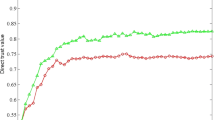Abstract
Wireless Sensor Networks (WSNs) are becoming more and more spread and both industry and academia are focusing their research efforts in order to improve their applications. One of the first issues to solve in order to achieve that expected improvement is to assure a minimum level of security in such a restrictive environment. Even more, ensuring confidence between every pair of interacting nodes is a critical issue in this kind of networks. Under these conditions we present in this paper a bio-inspired trust and reputation model, called BTRM-WSN, based on ant colony systems aiming at providing trust and reputation in WSNs. Experiments and results demonstrate the accuracy, robustness and lightness of the proposed model in a wide set of situations.
Similar content being viewed by others
References
Römer, K., & Mattern, F. (2004). The design space of wireless sensor networks. IEEE Wireless Communications, 11(6), 54–61.
Li, F., & Wang, Y. (2007). Routing in vehicular ad hoc networks: a survey. Vehicular Technology Magazine IEEE, 2(2), 12–22.
Marsh, S. P. (1994). Formalising trust as a computational concept. PhD thesis, Department of Computing Science and Mathematics, University of Stirling.
Marti, S., & Garcia-Molina, H. (2006). Taxonomy of trust: categorizing P2P reputation systems. Computer Networks, 50(4), 472–484.
Dorigo, M., & Gambardella, L. (1997). Ant colony system: a cooperative learning approach in the traveling salesman problem. IEEE Transaction on Evolutionary Computing, 1(1), 53–66.
Dorigo, M., Gambardella, L., Birattari, M., Martinoli, A., Poli, R., & Stützle, T. (2006). Ant colony optimization and swarm intelligence. In LNCS : Vol. 4150. 5th international workshop, ANTS 2006. Brussels: Springer.
Cordón, O., Herrera, F., & Stützle, T. (2002). A review on the ant colony optimization metaheuristic: basis, models and new trends. Mathware and Soft Computing, 9(2–3), 141–175.
Dorigo, M., & Stützle, T. (2004). Ant colony optimization. Bradford Book
Boukerche, A., Xu, L., & El-Khatib, K. (2007). Trust-based security for wireless ad hoc and sensor networks. Computer Communications, 30(11–12), 2413–2427.
Dhurandher, S. K., Misra, S., Obaidat, M. S., & Gupta, N. (2009). An ant colony optimization approach for reputation and quality-of-service-based security in wireless sensor networks. Security and Communication Networks, 2(2), 215–224.
Chen, H., Wu, H., Zhou, X., & Gao, C. (2007). Agent-based trust model in wireless sensor networks. In Eighth ACIS international conference on software engineering, artificial intelligence, networking, and parallel/distributed computing, SNPD’03 (pp. 119–124).
Ganeriwal, S., & Srivastava, M. B. (2004). Reputation-based framework for high integrity sensor networks. In SASN’04: Proceedings of the 2nd ACM workshop on security of Ad hoc and sensor networks (pp. 66–77). New York: ACM.
Michiardi, P., & Molva, R. (2002). CORE: a collaborative reputation mechanism to enforce node cooperation in mobile Ad hoc networks. In Proceedings of the IFIP TC6/TC11 sixth joint working conference on communications and multimedia security (pp. 107–121). Deventer: Kluwer, B.V.
Srinivasan, A., Teitelbaum, J., & Wu, J. (2006). DRBTS: distributed reputation-based beacon trust system. In DASC’06: Proceedings of the 2nd IEEE international symposium on dependable, autonomic and secure computing (pp. 277–283). Washington: IEEE Computer Society.
Buchegger, S., & Le Boudec, J. Y. (2004). A robust reputation system for P2P and mobile Ad-hoc networks. In Proceedings of the second workshop on the economics of peer-to-peer systems, Cambridge MA, USA.
Buchegger, S., & Boudec, J.-Y. L. (2002). Performance analysis of the CONFIDANT protocol: cooperation of nodes. In Proceedings of IEEE/ACM symposium on mobile Ad hoc networking and computing (MobiHOC). Lausanne: IEEE.
Almenárez, F., Marín, A., Campo, C., & García, C. (2004). PTM: a pervasive trust management model for dynamic open environments. In Privacy and trust, first workshop on pervasive security and trust, Boston, USA.
Glover, F. W., & Kochenberger, G. A. (2003). Handbook of metaheuristics (International series in operations research & management science). Berlin: Springer.
Li, L., & Halpern, J. Y. (2001). Minimum-energy, mobile wireless networks revisited. In IEEE International Conference on Communications, ICC 2001 (Vol. 1, pp. 278–283).
Sánchez, J.A., & Ruiz, P.M. (2006). Improving delivery ratio and power efficiency in unicast geographic routing with a realistic physical layer for wireless sensor networks. In Proc. 9th Euromicro conference on digital system design (DSD’06) (pp. 591–597).
Gómez, M.F. TRMSim-WSN, a trust & reputation models simulator for wireless sensor networks, http://ants.dif.um.es/~felixgm/research/trmsim-wsn.
Xiong, L., & Liu, L. (2004). PeerTrust: supporting reputation-based trust in peer-to-peer communities. IEEE Transactions on Knowledge and Data Engineering, 16(7), 843–857.
Author information
Authors and Affiliations
Corresponding author
Rights and permissions
About this article
Cite this article
Gómez Mármol, F., Martínez Pérez, G. Providing trust in wireless sensor networks using a bio-inspired technique. Telecommun Syst 46, 163–180 (2011). https://doi.org/10.1007/s11235-010-9281-7
Published:
Issue Date:
DOI: https://doi.org/10.1007/s11235-010-9281-7




